Matador Network's Blog, page 507
March 25, 2022
10 Colorado Cabins That Give You Easy Access To Mountain Adventures

Who doesn’t love taking long vacations and escaping to the mountains? Colorado is known for its desert land, river canyons, and especially its Rocky Mountains. No matter where you are, the scenery is just breathtaking. If you’re looking for adventure, these Colorado cabin rentals are the place to be.
Colorado cabin rentals in Summit CountyColorado cabin rentals near VailColorado cabin rentals near AspenColorado cabin rentals near DenverWe hope you love the Colorado cabin rentals we recommend! Just so you know, Matador may collect a small commission from the links on this page if you decide to book a stay. Listed prices are accurate as of the time of publication. See our full Advertiser Disclosure here.
Cabin rentals in Summit CountyRustic A-frame cabin in the mountains

Photo: Airbnb

Photo: Airbnb

Photo: Airbnb

Photo: Airbnb
This modern mountain retreat is the perfect place for your Colorado getaway. This 800-square-foot cabin features a full loft, spacious living room, kitchen, three beds for sleeping, and a sleeper sofa. There is a patio with a fire pit, a lounge area, and a propane barbecue grill. The cabin is minutes away from town, ski resorts, nightlife, and shopping.
Six guests, one bedroom
Price: $246 per night

Photo: Airbnb

Photo: Airbnb

Photo: Airbnb
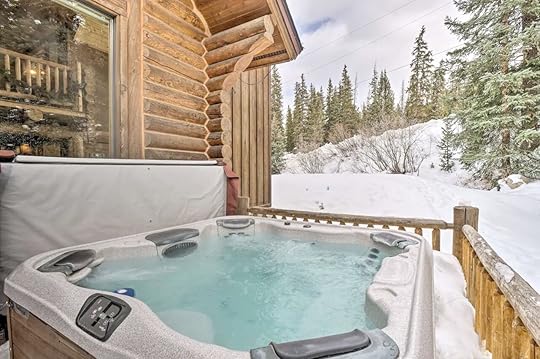
Photo: Airbnb
This cabin is one of the best Colorado cabin rentals for a family or friend’s vacation. There is more than enough room for everyone to find a comfortable spot to relax in with two stories. This gorgeous rustic mountain cabin features high ceilings and high-class furnishings, a remodeled kitchen, and more resort-like amenities. There is a wrap-around deck with a hot tub gas grill. There is also a nearby hiking trail and access to the Blue River.
Ten guests, three bedrooms
Price: $328 per night

Photo: Airbnb

Photo: Airbnb

Photo: Airbnb

Photo: Airbnb
Enjoy this newly renovated modern cabin retreat with stunning views. The cabin has a bright open kitchen with large windows that showcases the view. A spacious living room with contemporary themed furnishings and a front patio overlooks the mountains. There is a shuttle to town, and the property is just eight minutes to the Breckenridge Gondola.
Six guests, two bedrooms
Price: $198 per night
Cabin rentals near VailGrand cabin near downtown Frisco and Dillon Reservoir
Traveling to Colorado? Check out Matador’s guide to the best places to stay across the state:
10 Airbnb Estes Park rentals near Rocky Mountain National Park The best Airbnbs in Denver for beer, 420, and mountain culture Vail Airbnbs that make you feel like you’re in the heart of Bavaria Aspen Airbnbs to chill like a celebrity Stay near Garden of the Gods and Pikes Peak at these Colorado Springs Airbnbs

Photo: Airbnb

Photo: Airbnb

Photo: Airbnb

Photo: Airbnb
Immerse yourself in the Rocky Mountains with one of the mesmerizing cabins for rent in Colorado that shows every angle of the Rocky Mountains. This four-bedroom, 3.5 bath home features a big living room with two flat-screen televisions, entertainment centers, board games, and a fully equipped kitchen. The outdoor patio area has a covered porch, rocking chairs, and beautiful mountain views. Along with the central patio, the main bedroom has a balcony.
Ten guests, four bedrooms
Price: $255 per night

Photo: Airbnb

Photo: Airbnb

Photo: Airbnb

Photo: Airbnb
This secluded home is one of Colorado’s peaceful remote cabins. This rustic cabin is in the center of all the mountain adventures anyone can get into. The cabin has a fully equipped kitchen and a cozy living room with a stone fireplace with vaulted ceilings and exposed wood beams. The outdoor space features two decks and two dining tables and lounge furniture, a gas fire pit, and gorgeous views.
Six guests, two bedrooms
Price: $204 per night
Cabin rentals near AspenRemodeled 1940’s K Camp Ranch cabin

Photo: Airbnb

Photo: Airbnb

Photo: Airbnb

Photo: Airbnb
Escape to one of the many quaint and cozy Colorado cabin rentals, but this one sure does top them all. This remote cabin has everything you need for a peaceful getaway from the real world. The cabin is situated on a hillside ranch and features furnished with South American antiques. The cabin has a spacious living room with beautiful mountain views and a fully equipped kitchen. Guests are genuinely immersed in the beauty of the White River National Forest surrounded by pasturelands with grazing horses cattle.
Six guests, three bedrooms
Price: $339 per night

Photo: Airbnb

Photo: Airbnb

Photo: Airbnb
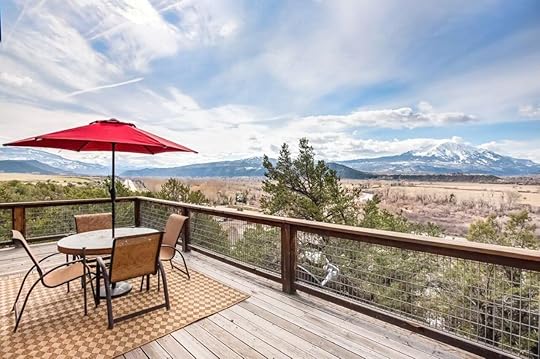
Photo: Airbnb
Check out this stunning and remote Colorado cabin that overlooks the town of Carbondale. This cabin has space for lounging in front of the fire in the open and spacious living room that gives stunning views of Mount Sopris. Enjoy and take in the spacious deck that overlooks Carbondale.
Six guests, two bedrooms
Price: $250 per night
Cabin rentals near DenverSkyRun cabin 15 minutes from Nederland, Colorado

Photo: Airbnb

Photo: Airbnb
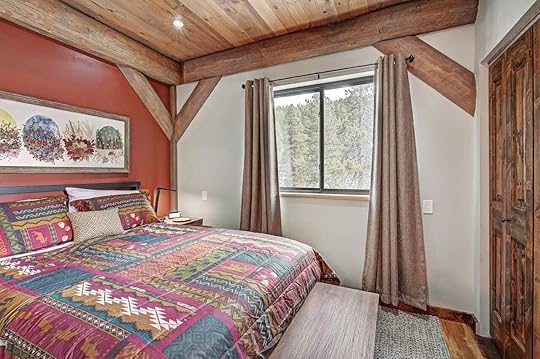
Photo: Airbnb

Photo: Airbnb

Photo: Airbnb
If you’re looking for the ultimate Colorado cabin rentals that give the utmost authentic cabin feel, this one’s for you. The open living room features a dramatic stone fireplace and beautiful mountain views. A full-sized kitchen with all appliances is fully stocked for your cooking needs. The cabin is 15 minutes from the Nederland Colorado and the Eldora ski resort and just 30 minutes from Black Hawk and Central City.
Four guests, two bedrooms
Price: $276 per night

Photo: Airbnb

Photo: Airbnb

Photo: Airbnb

Photo: Airbnb
This centrally located cabin is a remote Airbnb cabin Colorado property that is the perfect home base for a couple, solo or family getaway. The cabin is just off Highway 285 and nestled in tall pine trees. It features a cozy living room with a wood-burning fireplace as its centerpiece and an open and spacious, fully equipped kitchen. The cabin does include an attached mudroom that can house sporting equipment.
Six guests, two bedrooms
Price: $514 per night
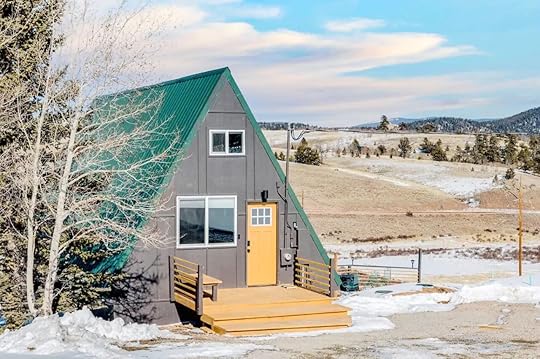
Photo: Airbnb
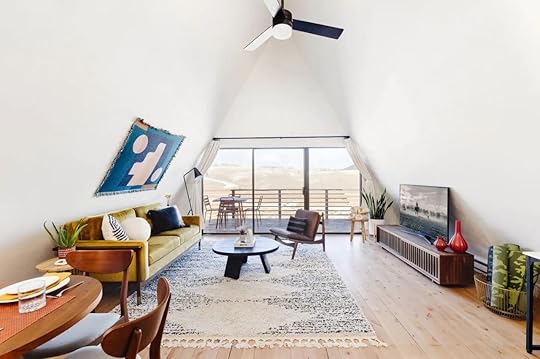
Photo: Airbnb

Photo: Airbnb

Photo: Airbnb
This secluded A-frame cabin is the ideal place to come and unwind and take a break from your fast-paced schedule. The cabin has a central living area that is spacious, bright, and airy and immediately puts you into relaxed mode. The fully renovated and stocked kitchen has everything you need for a full course meal and a cup of coffee. There is a private hot tub and along with it are the stunning views that you would have while in the hot tub. 
Four guests, one bedroom
Price: $185 per night
A Korean Pojangmacha Tent Is a ‘Psychiatrist’s Office’ Where You Can Drink and Snack

In the United States, street food is a central part of our culinary landscape. We’re lucky enough to have hot dog and halal carts, food trucks that serve all manner of cuisines to go, and roadside stands that offer hamburgers and ice cream cones. South Korea has a similar love affair with street food, where casual meals are sold from vendors called pojangmacha.
Pojangmacha street food vendors are a relatively new tradition in South Korean culinary history that’s only been around for 60 years. There are many legends regarding the origins of pojangmacha tents, the English translation of which is something close to horse drawn wagon or cart. Some accounts say that the street food stalls are modeled after Japanese yatai, a type of mobile street food cart, while others claim that pojangmacha are more closely related to horse drawn food carts that have existed in Korea since at least the 14th century. But most people agree that pojangmacha vendors appeared as the Japanese occupation of Korea came to an end in the 1950s.
No matter how long these street food stalls have been around in some form or another, pojangmacha have become a staple of the food scene in big cities, especially Seoul. In fact if you watch a lot K-dramas, you might notice pojangmacha stalls pop up in scenes where the characters are drinking away their sorrows. Fans of the smash hit Netflix show Squid Game will recognize the familiar red tarps of a pojangmacha, too: The main character Gi-hun takes his daughter out for tteokbokki in one of the red tents on her birthday.
If you’re passing through the country, a stop at a pojangmacha tent to sip soju and confess your innermost thoughts and feelings over platters of fiery hot tteokbokki is an absolute must. Here’s everything you need to know about visiting a pojangmacha, including where to find them and what to order.
What is a pojangmacha
Photo: Nokuro/Shutterstock
While visitors to big cities like Seoul, especially those coming from the West, might be used to street food snacks that are sold from cart, a pojangmacha has one stand out characteristic that makes it unlike most other street food stalls in world: They are outfitted with plastic tarps, hanging from each side, which makes a pojangmacha more like a food tent than a food stall. Underneath the tarps plastic stools might be set up around the counter where the owner is serving food, while some larger pojangmacha tents might have tables available.
Groups of pojangmacha are concentrated most heavily in Seoul’s Jongno District, home to the Gwangang Market and so-called food alleys, where vendors focus on dishes like rice cakes and baby octopus. According to The Korea Herald, “nostalgia and the informal atmosphere of the makeshift bars always seem to draw those going out for a quick drink.”
In fact, these food stalls are famous as not just bars but judgment-free confession booths, where Korean people feel comfortable throwing back glasses of soju and getting emotional, rowdy, and sentimental — or all of the above. One travel blogger even referred to a pojangmacha as a mobile “psychiatrist’s office.” As for the clientele, you’ll see both young Koreans winding down from a night on the town and older Korean people, too, who remember when there was pojangmacha on every corner.
Unfortunately, in the last ten years or so, pojangmacha have become much less common in Seoul. In her video exploring pojangmacha, Youtuber Kring Kim and a friend explain that pojangmacha have mostly been banned by the government because they block traffic.
What to order at pojangmacha
Photo: mnimage/Shutterstock
Before tourists stop by a pojangmacha tent, they should know that vegetarian options are limited. But there is good news for visitors from out of town: In her video Kring Kim shows a menu that lists food items in Korean and English.
It’s also common to crack open a bottle of soju while tucking into your meal, so you’ll probably see a lot of late night snackers and bar hoppers bringing the party to a second location if you stop by a pojangmacha at night. In fact, most of the snacks served in pojangmacha tents are categorized as anju – food that is meant to be served with alcohol.
Tteokbokki: These chewy cylinder shaped rice cakes are drenched in spicy gochujang chili paste.
Dakkochi: Scallions and pieces of chicken grilled on a skewer and coated in a sticky sauce made from soy sauce and gochujang.

Photo: Pitapat/Shutterstock
Ho-tteok: Crispy pancakes filled with cinnamon and brown sugar cinnamon that can also be found in green tea flavor and with savory fillings like kimchi.
Gimbap: These seaweed and rice rolls might look similar to sushi but what differentiates them is that they are filled with cooked ingredients, like bulgogi, ham, cheese, kimchi, fried egg, and fish cakes.
Sundae: The Korean version of blood sausage, made from pork blood mixed with dangmyeon, or vermicelli noodles.

Photo: ARTYOORAN/Shutterstock
Odeng: This variety of Korean fish cake (made from white fish like cod or pollock) is typically cut into strips and served on a skewer, alongside a cup of simple borth seasoned with ingredients like kelp or radish.
Gyeran-mari: This rolled egg dish is filled with chopped root and scallion and is especially popular around lunch time. 
cheapest cities to live in

Travelers, digital nomads, and wannabe expats with a small budget but a determination to see the world should focus their attention on five locations deemed the cheapest cities to live in. Statista, a data provider, compiled the results of a survey carried out by Time Out earlier this year to map the world’s cheapest cities to live in.
 You will find more infographics at Statista
You will find more infographics at Statista
The survey included 27,000 people who were asked if their city was an expensive one to live in, and it turns out that there are still places in the world where one can settle without constantly worrying about finances. Only 10 percent of the inhabitants of Manchester thought their home turf was too pricey, and surprisingly, just 17 percent of people of Montreal, Budapest, and Johannesburg thought the same of their necks of the woods.
The survey includes the city of Saint Petersburg in Russia, believed to be an expensive place to live by only 18 percent of its people. But despite the fact that it’s one of the cheapest cities to live in, and a beautiful city at that, the current war waged by Russia in Ukraine makes it a big no-no for expats and travelers.
The cheapest cities in the world to live inManchester, EnglandMontreal, CanadaBudapest, HungarySaint Petersburg, RussiaJohannesburg, South AfricaPrague, Czech RepublicOn the other end of the spectrum are the most expensive cities to live in, which features the usual suspects: Zurich, Switzerland, which 99 percent of the people surveyed thought was overpriced, and Paris, France (which at least one remote worker believes can be cheaper than living in suburban America).
A 2021 report of the most expensive cities for expats also featured Zurich, as well as two more Swiss cities, Geneva and Bern, alongside Hong Kong, Tokyo, Singapore, and more.
While Zurich often tops off the lists of eye-wateringly expensive places to visit and live, there are ways you can make a trip to largest cities in Switzerland a little easier on the wallet. Also, when compared to San Francisco, the cost of living in Zurich does not seem that much more exorbitant.
How To Travel During Mercury Retrograde

Ahh the infamous Mercury retrograde — not actually a time to be feared but rather used as reflection, reassessment, readjustment, and refinement (basically all the “re’s”). Mercury is the fast-moving planet that governs communication and travel, amongst other things, hence why when it visibly turns retrograde (which is really an illusion), it can cause all manner of technological and travel mishaps. But what if you simply can’t avoid travel during a Mercury retrograde and rescheduling isn’t an option? Read on for six tips on how to foolproof your travel plans!
What is Mercury retrograde?Before we get into it, let’s discuss what a retrograde is. A planet is said to be in retrograde when it appears to be moving backwards from our vantage point on Earth due to our respective speeds. It’s actually an optical illusion. Because of this, and because Mercury rules the intellect, our thought patterns, and how we express ourselves too; we can feel a little foggy during this time, and miscommunication is possible — unless you were born during a Mercury retrograde in which case you might feel right at home!
Professional astrologer Nala Ferreira shares with Matador Network: “Mercury in Astrology rules communication, traveling, and transportation. When appearing to be moving backwards, those topics seem to go in disarray, and not functioning well during this time. When questioned about what can happen specifically to planning a trip, Ferreira says, “Travel can be particularly challenging, but nothing to be scared of, retrogrades aren’t the end of the world and you shouldn’t put your life on hold. Just make sure that you double-check the time of your flight, your documents, and plan ahead, but be flexible in case of delays or casual technological errors.”
When is Mercury retrograde in 2022?Mercury typically stations retrograde three to four times a year, making it relatively common. The next motion starts on May 10 through to June 2. There are two more periods to keep in mind September 9 to October 2 and December 29 to January 18, 2023. Again, when this is happening, it is an invitation to slow down and bring awareness to our daily lives. Here is how you can move through it with ease.
1. Double check the detailsWhile this may seem obvious, nothing is to be overlooked during Mercury retrograde. In fact, triple-check all the facts, details, dates, times, and information on everything. Again, if it is possible to literally move the date so it doesn’t fall during the Mercury retrograde period, then it could be beneficial to take that option.
Otherwise, keep on checking those figures (the same advice goes for signing new contracts, which Mercury also rules), and stay up to date on any changes and write important trip planning information out on paper as well as having it stored in your phone.
2. Check in with communicationYou may be all up to scratch, but is everybody else on the same page? Everyone will be affected by a retrograde to differing degrees depending on their natal chart placements, and so while you may not feel the effects so much — other people you are traveling with might. Miscommunication is very possible during Mercury retrograde. This also goes for making sure you’ve understood correctly what someone is saying and that you are effectively expressing yourself in return.
3. Have a back up planWhat would happen if your flight got canceled, your car bursts a tire, or you do get the wrong date, time, etc.? When traveling during Mercury retrograde, it is more than wise to have a backup plan, or two, in case of sudden curveballs and changes to itineraries and schedules. What’s the worst that could happen, figure out what you might do if certain situations occurred and prepare.
4. Be prepared for delaysSo your flight has been delayed for a few hours or your bus hasn’t shown up yet, what now? After you’ve re-informed yourself of any updates (it could also be beneficial to download relevant travel apps), you can use the time to your advantage! Be prepared with ample snacks, drinks, books, and charging appliances. If you know that traveling in general already makes you stressed, get a head start on stocking up with the things that help keep you calm. Perhaps that’s packing chamomile tea and lavender essential oil, or maybe you know that a certain crystal soothes your nerves or you love coloring books.
5. Get insuranceYou should probably already have insurance when traveling, but especially during Mercury retrograde! If something is going to occur, you’ll be glad to be compensated for it. As mentioned Mercury retrograde also governs technology. The last thing you would want is for your camera to stop working on vacation or your phone to get lost while trying to navigate foreign neighborhoods. Same goes for backing up all your data or an important account before you leave home.
6. Use the time for reflectionIf a travel delay or other issue does occur, perhaps you can use the time to meditate, listen to a podcast, do some journaling, or strike up a conversation with a stranger. Mercury, the planet of the mind, wouldn’t go retrograde so many times a year if there wasn’t a message in that for us to slow down and pay attention to the world in and around us. You can also use the time to research your final destination, which is always useful. Or, simply catch up on that Netflix series you were proactive about and downloaded before getting to the airport.
While it’s not always feasible, nor required, to readjust our lives around a planet’s movements, we can take the invitation to be a little more mindful of our actions during this period to (hopefully) avoid any mishaps. And if any travel blunders do occur, we can take them as an invitation to learn something about ourselves and the process too. 
March 24, 2022
Poisonous Pufferfish Are a Delicacy in Japan. Here’s How and Where To Eat Them Without Dying.

Known in one region as ‘fuku’, meaning luck and in another as ‘teppo’ meaning gun, the infamous Japanese pufferfish is the Russian roulette of the dining world. Laced with a poison that kills in hours and has no cure, in Japan the delicacy can only be prepared by trained chefs with years of experience and is, understandably, a rare and expensive dish.
The draw of such a dangerous meal? A subtly-flavored flesh that’s high in protein, low in fat, and has a refined richness only fit for fine dining. Urban legend says that the only dish the Japanese emperor is forbidden from eating, but the added risk is an undeniable attraction. Fear does heighten the senses after all.
Why is fugu dangerous
Photo: Kit Leong/Shutterstock
The poison excised from this delicacy is tetrodotoxin: lethal in as little as 2 milligrams and found in the organs of the pufferfish, particularly in the liver. The poison is not produced by the fish itself but builds up through their consumption of microorganisms from the sea. If unfortunate enough to ingest any, diners will quickly lose sensation in their mouth before the paralysis spreads; death usually occurs in a matter of hours. Deaths are rare but not unheard of – only 23 people have died from eating fugu in the past two decades, according to the BBC.
The deadly fish has long been regulated thanks to its dangerous quality and was outlawed entirely in the 16th century. It did not return to diner’s plates for 300 years, although it was still enjoyed behind closed doors. According to the legends of Shimonoseki – Japan’s self-proclaimed fugu capital – faced with a storm and no fresh catch, a local restaurant owner served fugu to the first prime minister of Japan, risking the punishment of death in doing so. He was so impressed by her dish, he requested that the prefectural governor lift the ban, with the restaurant, Shunparo, often fabled as the first official fugu restaurant in Japan.
To this day, preparation at home is illegal as is the sale of the pufferfish organs; regulated training and certification is required for chefs who plan to prepare fugu. In learning to artfully remove the organs and do so without leaving traces of poison behind, chefs must train for two years, practicing on over 100 fish and spending thousands of dollars in the process. Licenses can be revoked, with an infamous case of a two-Michelin starred chef being stripped of his after serving an insistent customer the fugu liver, as reported in the Wall Street Journal. While she recovered from paralysis after a few days, it could easily have been fatal.
How to eat fugu in Japan
Photo: alessandro uboldi/Shutterstock
Once prepared, the fish offers a surprising variety of mediums at which to (minimally) risk your life. Sashimi is the go-to preparation method, with paper-thin slices of pufferfish flesh laid out in the design of a chrysanthemum. It’s a beautiful display, but the chrysanthemum is the Japanese flower of death. For a warmer dish, tecchiri nabe is a fugu-filled hotpot offering chunks of fish and seasoned vegetables in a light dashi broth. Both are served with ponzu, a citrus sauce often mixed with soy sauce and providing the perfect sharpness to accompany the subtle flavor.
Fugu tataki is a happy medium between cooked and raw, with the skin flash-seared before the fish is served in thick slices, accompanied by sadachi lime and myoga, Japanese ginger.
For those seeking a more casual dance with death, a contemporary twist is fugu karaage – dipped in batter and deep-fried, or crispy fried fugu-skin, the perfect snack to pair with a cold beer. For a final nightcap, fugu-sake or hirezake sees a charcoal-grilled fin placed in warm sake and steeped for a few minutes, adding a smokey, savory flavor to this traditional spirit.
Fugu season is from October to March; from April to June the pufferfish is actually considered more toxic due to its reproductive cycle, so spring is not the ideal season to sample this dish. Tiger puffer, tora-fugu, is sometimes known as the king of pufferfish and is only available in winter. Here are four restaurants where visitors to Japan can try delicious, delicate, and most importantly, safely prepared fugu.
Where to eat fugu in Japan
Photo: HikoPhotography/Shutterstock
Shunpanro, Yamaguchi
Japan’s first recognized fugu restaurant, Shunpanro is located in Shimonoseki and has been serving fugu (officially) for over 130 years. The traditional kaiseki-style restaurant hosts multi-course fugu dinners with views of the Kanmon Strait, the source of the city’s pufferfish bounty. Exquisitely thin usuzukuri are their signature dish, believed to hold the essence of fugu dining, along with hot pot, deep-fried and soup courses. The options begin with a nine-course menu, costing $220 and reaching up to $300 for eleven courses.
Address: 4-2 Amidaji-cho, Shimonoseki, Yamaguchi, 750-0003, Japan
Kitahachi, Osaka
Kitahachi is owned by Kiichi Kitahama, known as Dr. Fugu. Well into his nineties, Kitahama learned the trade from his father and went on to earn two Michelin stars. He later became chairman of Japan’s Fugu Association. There is a small museum beside the restaurant, and while Kitahama doesn’t always prepare the fish these days, he is often around to keep a watchful eye on his skilled chefs. Courses start at $300 and many opt for omakase, chef’s choice.
Address: 24-14 Gokenyamachi, Kishiwada, Osaka, 596-0055, Japan
Usukifugu Yamada-ya, Tokyo
The long-established sister restaurant of the original family-run fugu ryotei in Oita prefecture, Usukifigu also earned two Michelin stars for its fugu dishes. Multiple fugu courses are served, starting at just under $300 for six courses, with the fugu flown in from Oita’s Bungo Channel in southern Japan. Their specialty is sashimi served with homemade ponzu sauce, made using fruit from Oita.
Address: 4-11-14 Nishiazabu, Minato-ku, Tokyo, 106-0031, Japan
Fukushin, Kyoto
Fukushin gets its pufferfish from Shimonoseki and takes its name from the regional dialect’s translation for the fish, meaning luck, and shin, meaning fresh. They have specialized in fugu and hamo fish (dagger tooth conga) for over 50 years, with skilled chefs removing needle-thin bones from the hamo without cutting through the skin. Menus combine these expertly prepared dishes into luxurious courses including hirezake, sashimi and mixed platters for those wishing to try a variation, starting from $150 per person.
Address: 237 Nishikiyachodori, Sendocho, Shimogyo, Kyoto, 600-8019, Japan 
This Interactive Map Shows the 50 Most Filmed Streets in the United States

There are streets you know because you’ve seen them before, and then there are streets you know because you seen them on screen. American Home Shield, a home warranty company, scoured shooting location data on IMDb to find the streets in the United States that most often make it into movies and shows.
Los Angeles and New York City get the most love with nine out of 10 of the most filmed streets. Additionally, 44 of the top 50 locations are in California or New York.
Hollywood Boulevard, with its convenient location next to the nexus of the American film industry, is appropriately the most filmed street. The IMDb research found 133 movies and shows on Hollywood Boulevard. Notably, not all are of those depictions are labeled as Hollywood Boulevard in movies and shows.
I became accustomed to recognizing filming locations while growing up in California and later living in New York City. It’s like finding a little Easter egg — especially when you notice that place that is supposedly shown on the movie or show is actually somewhere else (or when the depiction is off, which was the case in The Gilded Age).
I lived in New York City’s Washington Heights during the filming for Daredevil, and my street and entrance to my apartment was shut off for a few days one summer. Turns out the showrunners needed somewhere that had a bit more of an edge to depict Hell’s Kitchen, which by that point had already largely been turned into a playground of clubs, restaurants, and overpriced bars.
The most filmed locations in New York trend toward the more glamorous, though. Park Avenue is the second most filmed street overall, while Broadway and Wall Street have many depictions of their own.
Outside of New York City and LA, other popular filming locations include San Francisco (Market Street), Chicago (Wacker Drive), and New Orleans (Bourbon Street).
The 10 most filmed streets in the United StatesHollywood Boulevard in Los Angeles, California: 133 Park Avenue in New York City, New York: 61Market Street in San Francisco, California: 22Rodeo Drive in Beverly Hills, California: 20Bourbon Street in New Orleans, Louisiana: 16South Virginia Street in Reno, Nevada: 12East Fremont Street in Las Vegas, Nevada: 10Lower Wacker Drive in Chicago, Illinois: 7Center Street in Piru, California: 7Boardwalk in Atlantic City, New Jersey: 6To make the map, AHS used movies listed on IMDb from 1900 to 2020 with data about filming locations. Only the routes and intersections were included using Google Geocoding API, and the team counted the number of times a street was filmed (landmarks or specific locations on a street were not).
Using this map, you can set up a street tour for yourself, and add the real locations of your favorite TV homes into the mix while you’re at it. 
Your Photo-Filled Guide To Seeing the Best Tulips in and Around Amsterdam This Season

There’s nothing like tulip season in Amsterdam. The Netherlands is world famous for its tulips, and becomes a colorful patchwork of flower markets, gardens, and exhibitions every spring. This year, after a two-year hiatus due to the pandemic, tulip season will be in full bloom with close to no COVID restrictions.
Tulips are originally from the Middle East and Central Asia. The flowers became popular in Holland after they were planted by the 1590s, and over the next century became a high-priced status symbol with their own stock exchange established in 1636.
The bubble popped in 1637 (an event known as Tulipomania), though the tulip love carries on. The Netherlands exports about $6.8 billion of flowers annually. It makes up about 60 percent of the global cut flower trade with 1.7 billion every year.

Photo: Foxphotoss/Shutterstock
It’s not just tulips, of course. March is the start of crocus season (lavender, yellow, and white flowers in the iris family), and then daffodils and hyacinths come out. Tulips are actually the last of the spring flowers in the Netherlands. Tulips reach peak bloom in mid April and last until early May in and around Amsterdam.
Cool nights bring the tulips out, and the consistently moist soil conditions in the Netherlands helps, too. In particular the polders, which are plots of land surrounded by water — whether that be land reclaimed from a lake, a flood plain, or marshes.
While tulips fill Amsterdam in the spring, it’s not where they’re primarily grown. The nearby Flevoland province has the majority of tulip farms, with The Hague, Leiden, and Alkmaar having a large number as well. That said, you don’t have to look far to find tulips in many rural areas near Amsterdam and much of the Netherlands.
For the best experience, you’ll want to head about 30 minutes outside of Amsterdam to the Keukenhof, which is the world’s biggest flower exhibition and more than 7 million bulbs bloom through spring. Another world’s biggest — in this case flower auction — is at FloraHolland in Aalsmeer, also about a 30 minute drive from Amsterdam.
Here are the best ways to see tulips in the Netherlands.
Royal FloraHolland
Photo: Jordan Tan/Shutterstock
More than 20 million flowers and plants are sold through this auction company with locations in Aalsmeer, Naaldwijk, Rijnsburg, Venlo, Bleiswijk, and Eelde. Ninety percent of the Dutch flower trade comes through the company, which handles plants (primarily roses, tulips, and chrysanthemums) from 50 countries. Aalsmeer is the best option for tourists from Amsterdam, as there’s a visitors center where early risers can see the action for themselves.
Royal FloraHolland tickets (€10 per person)
Keukenhof
Photo: MarinadeArt/Shutterstock
More than 7 million flowers bloom at Keukenhof in the spring. It’s a must-visit for any flower lovers (or anyone who wants that perfect photo in front of flowers), as it’s the largest flower park in the world. Along with tulips, there are carnations, daffodils, hyacinths, orchids, roses, lilies, and others. Best of all it’s easy to get to — just 30 minutes whether you’re coming from Amsterdam, The Hague, Haarlem, or Leiden.
The season for visiting is as short as the bloom season. Keukenhof opens its gardens and four pavilions from mid-March to mid-May. You also won’t be alone, as more than a million people visit.
If you came for the wrong season, Keukenhof Castle has 150 different types of dahlias that are showcased during Keukenhof Dahlia Days at the end of August.
Tulips in Amsterdam
Photo: Noppasin Wongchum/Shutterstock
The city starts tulip season early in January with a temporary, 200,000-tulip garden on Dam Square that visitors can pick for free. This ends before peak tulip season, but there will still be plenty of flowers at museums, gardens, and elsewhere around the city to see throughout April during the Tulp Festival (which lasts as long as the bloom). There are 5,000 tulips of 100 varieties at the Hermitage Amsterdam’s public garden alone.
Bloemenmarkt, the floating flower market, is perhaps the most famous Amsterdam flower attraction. It’s year-round, but tulip season makes for a special time. The Amsterdam Tulip Museum in the Jordaan (€5) can provide you with more tulip history and bulbs.
Bollenstreek (Flower Strip)
Photo: Kim Willems/Shutterstock
Get outside of Amsterdam to see a 12-mile road from Haarlem to Leiden that’s lined with tulips, crocuses, daffodils, and hyacinths. Do as the Dutch do and see the strip by bike (cars work too, though).
Visit a picking garden to gather your own tulips
Photo: Seasonsoflife/Shutterstock
Hillegom, about a 45 minute drive or train from Amsterdam, is where you’ll find Annemieke’s Picking Garden. Here, you can pick some flowers of your own from the greenhouse any pay by the flower. Think of it like the spring version of one of those pick-your-own apple experiences.
De Bollenburcht near Lisse (about 40 minutes from Amsterdam) also allows visitors to pick their own tulips in April and May from a selection of 100 varieties.
9 of the Best Adults-Only All-Inclusive Resorts in the Caribbean

Few settings are as relaxing as a blissful Caribbean beach — until a toddler throws a tantrum because the ocean is too wet or the siblings seated next to you start squabbling over who gets the better sun lounger. Sometimes, adults just want a peaceful beach vacation free from kids. And that’s okay. Fortunately, plenty of Caribbean islands have all-inclusives made just for grown-ups. From the Dominican Republic to the Bahamas, these are the best all-inclusive Caribbean resorts for adults only where your meals, activities, and peace of mind are all taken care of.
We hope you love the all-inclusive adults-only resorts we recommend! Just so you know, Matador may collect a small commission from the links on this page if you decide to book a stay. See our full Advertiser Disclosure here.
1. Secrets Cap Cana Resort & Spa — Punta Cana, Dominican Republic
Photo: Booking.com

Photo: Booking.com

Photo: Booking.com
Of all the Caribbean islands, the Dominican Republic is the most visited. And for many visitors, Punta Cana is the first and only stop. All-inclusives are as common as palm trees here, which can make choosing the right one challenging — unless you want an adults-only getaway. Secrets Cap Cana is tucked away in a gated community on Juanillo Beach whose balmy waters are rivaled only by the resort’s lagoon-style infinity pool. Couples are treated like VIPs here, with special promos for honeymoons, anniversaries, vow renewals, and even elopements, although the girlfriend’s getaway package is pretty enticing too.
2. The Caves Hotel — Negril, Jamaica
Photo: Booking.com

Photo: Booking.com

Photo: Booking.com
Unlike the massive, multi-story resorts many of us associate with all-inclusives, The Caves Hotel promises a boutique experience and a cliffside setting that blends right into the scenery, with a front-row view to the iconic neighboring Negril lighthouse. The hotel only has 12 cottages and suites. The rest of the property is devoted to lush gardens; enchanting grottos, one of which houses a rum bar; a romantic cavern restaurant, a saltwater pool and oceanview whirlpool, and a full-service Aveda spa. Although there’s no beach access, water sports ranging from snorkeling and kayaking to cliff-jumping are all on offer here.
3. Sonesta Ocean Point Resort — Maho Village, Sint Maarten
Photo: Booking.com

Photo: Booking.com

Photo: Booking.com
This adults-only resort on Sint Maarten, the Dutch half of the split Caribbean island of Saint Martin, gives classic all-inclusive vibes. It’s located right on Maho Bay a short drive from Princess Juliana International Airport, which just so happens to be one of the most thrilling airports travelers can fly into. There’s plenty to do without ever leaving the property, from the resort’s three pools and restaurants to its four bars and lounges. When you do decide to venture into Maho Village, test your luck at neighboring Casino Royale, the island’s largest gaming emporium. Then head back to Sonesta for a morning massage at the Serenity Spa.
4. Serenity at Coconut Bay — Eau Piquant, Saint Lucia
Photo: Booking.com

Photo: Booking.com

Photo: Booking.com
Serenity at Coconut Bay is not just an all-inclusive adults-only resort — it’s designed specifically for couples. Everything about the resort is catered toward romance, starting with luxurious suites that open to private plunge pools. Equally impressive is the promise of butler service, which allows couples to arrange exclusive pool and beach cabanas, book in-room spa treatments, enjoy patio breakfasts and candlelit dinners for two, and have bubble baths drawn before bed. You can even have your bags unpacked and pressed for you on arrival.
5. Warwick Paradise Island — Nassau, Bahamas
Photo: Booking.com

Photo: Booking.com

Photo: Booking.com
While the homey rooms and suits make Warwick Paradise Island feel like your very own condo in the Bahamian capital, the resort’s endless amenities are quick to remind you why all-inclusives can be better than rentals. To start, there are five restaurants, two bars, a private harbor, and a beautiful white-sand beach at your fingertips, with a long list of daytime activities and nightly entertainment on offer. Topping it all off is a 10,000-square-foot terrace that’s the perfect vantage point to admire the marina. Guests ages 16 and older are welcome at Warwick Paradise Island, making this resort the perfect choice for families with adult children.
6. Hotel Riu Palace Antillas — Noord, Aruba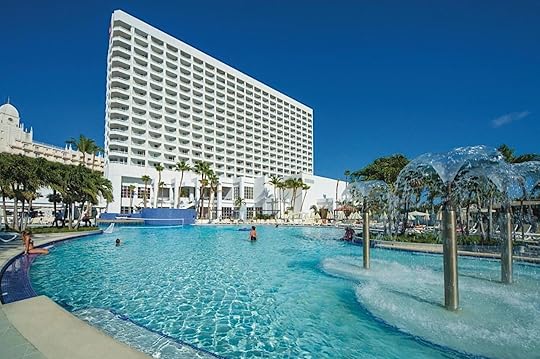
Photo: Booking.com

Photo: Booking.com
Rubbing elbows with some of the finest luxury accommodations in Aruba, Hotel Riu Palace Antillas is located on Palm Beach, one of the most popular spots on the island to dine and drink, shop for souvenirs, and try just about any water sport under the Caribbean sun, from banana boating and parasailing to water skiing and flyboarding. While the beach can get crowded, booking a room at this resort ensures you’ll get a spot in the sand. Better yet, spring breakers are not permitted here as they are at some other Hotel Rui properties, so you can rest assured that the resort’s dancefloor, casino, and nightlife will be fun without being overrun by students.
7. Sandals LaSource Resort & Spa — Saint George’s, Grenada
Photo: Booking.com

Photo: Booking.com

Photo: Booking.com
Located in the hilly Grenadian capital, which is surrounded by a volcanic crater, this adults-only Sandals resort is a dream vacation for water lovers. Not only do guests have exclusive access to the island’s Pink Gin Beach, but they can also take advantage of the resort’s PADI-certified scuba center, snorkel gear, Hobie Cats, paddleboards, and kayaks, all of which come with professional instructors for beginners. If that’s not enough, this resort has some of the coolest hotel pools you’ll ever see, including “pools in the sky and living rooms in the swimming pools, private plunge pools, cascading waterfalls, and meandering river pools.”
8. Cocobay Resort — Valley Church, Antigua
Photo: Booking.com

Photo: Booking.com

Photo: Booking.com
Location is everything at the Cocobay Resort on Antigua’s west coast. About 45 minutes from the airport and 25 minutes from the Antiguan capital, Satin John’s, the resort is far enough away from the island’s hubs to feel remote yet close enough to be convenient. Immediately surrounding the resort are no fewer than six spectacular beaches, and the fun-packed Jolly Harbor complex is just a few minutes away for golfers, tennis players, boaters, shoppers, casino-goers, and bar-hoppers. Back at the resort, guests stay in beautiful hillside cottages that put the island’s natural splendor on full display.
9. Club Med Turkoise — Providenciales, Turks and Caicos
Photo: Club Med

Photo: Club Med

Photo: Club Med
A pioneering all-inclusive brand, Club Med knows what it takes to create a resort that keeps guests coming back. Turkoise is no exception, starting with its gorgeous location in Grace Bay next to a turquoise lagoon. Scuba divers are among the travelers who’d be wise to snap up a room here as the Turks and Caicos is known for coral walls and sunken wrecks that the resort is happy to help divers explore. But the excitement doesn’t stop there. Energetic travelers can participate in a long list of beachy activities here — including a heart-pumping flying trapeze. 
Travel Industry Leaders Propose Timeline To End Mask and COVID Mandates by Summer

The US Travel Association, a non-profit organization that represents all aspects of the travel industry, wrote a letter to the White House with a list of which COVID travel restrictions and mandates should end and when.
The letter, seen by Reuters, noted proposed the following:
Immediately end pre-departure testing for fully vaccinated international arrivals coming to the US.Repeal the federal mask mandate for all public transportation (including air travel) by April 18, or announce a plan to end the mandate in the subsequent 90 days.End “avoid travel” advisories, which currently hold for about 120 countries, as well as travel bans.In addition to the more immediate proposals, the letter asked for a plan to be ready by June 1 to end all remaining travel restrictions like vaccine mandates. The UK and Canada have already taken similar steps. Notably, testing already isn’t required for Americans visiting Canada or Mexico.
Ending the mask mandate for public transportation is in line with following the science and recommendations from the experts: The CDC said in mid-March that 99.5 percent of the US population lives in a place where masks aren’t needed due to low COVID levels.
The current federal mask mandate is in place through April 18.
Airlines are onboard with some of the changes as well for the first time since COVID travel measures started. Not long after the US Travel Association letter was made public, executives at American Airlines, Delta, United and others asked President Joe Biden to let the federal mask mandate expire on its intended date rather than extend it once again. Additionally, the airline executives asked that the mandate for proof of a negative coronavirus test end as well.
“The persistent and steady decline of hospitalization and death rates are the most compelling indicators that our country is well protected against severe disease from Covid-19,” the airline execs wrote in a letter obtained by the New York Times. “Given that we have entered a different phase of dealing with this virus, we strongly support your view that ‘Covid-19 need no longer control our lives.’”
cost of living in Zurich vs SF

When my family and I moved to Zurich, Switzerland, in 2019, locals there would often ask how I was coping with the high cost of, well, everything. After all, Zurich is famously costly — ranking as one of the world’s most expensive cities for expats.
I’d reply that in fact I wasn’t finding it pricier than the city we’d moved from: San Francisco, another exorbitant metropolis. At least in terms of rent and bags of groceries, the cost of living in Zurich seemed very similar to that of San Francisco . Zurich wasn’t that expensive, I thought.
Until we ate out.
Turns out eating out in Switzerland ranges from uneconomical to eye-watering — no matter the cuisine or venue. While San Francisco restaurants are relatively pricey, they don’t come close to those in Zurich. One reason for Zurich’s high eating-out prices is labor costs, since employees are paid a living wage. Zurich restaurants also charge for water, as in $9 for a bottle and $2 per person for tap water.
The cost of living in Zurich is also linked to the high cost of ingredients in Switzerland. Meat is more expensive in Switzerland than anywhere else. The country isn’t in the European Union, so it can block more cheaply produced meat to protect its farmers, who are legally barred from raising too many animals. Swiss farms are small, averaging fewer than 50 acres each, making for a lovely landscape but pricey steak and broccoli. At least top-quality cheese is affordable. That’s a good thing, because it’s a key ingredient in some of Switzerland’s most delicious foods.
Switzerland also makes excellent wines that are all consumed in-country. Secretly spectacular reds come from the Vaud and western Valais regions, while crisp, balanced whites are products of tiny vineyards throughout the country.
Cost of living in Zurich, Switzerland, vs San Francisco, CaliforniaGroceries$70/bag in Zurich vs. $60/bag in San Francisco
Meat: Organic chicken breast $18/lb in Zurich, $7/lb in San FranciscoNaturally raised beef $45/lb in Zurich, $20/lb in San FranciscoHigh-end cheese, like caved-aged Gruyere: $12/lb in Zurich, $25/lb in San FranciscoOrganic broccoli $4/lb in Zurich, $3.50/lb in San FranciscoRestaurantsEating at restaurants is more expensive in Zurich than in San Francisco, at every level.
Lunch at a mid-priced restaurant $35 in Zurich, $25 in San FranciscoDinner at a hip restaurant with one glass wine $95/person in Zurich, $65 (pre-tip) in San FranciscoBeer and WineThe price of beer and wine is about the same in Zurich and San Francisco.
A bottle of good white or red is $20 in Zurich, $20 in San Francisco6-pack of microbrew beer $12 in Zurich, $12 in San Francisco CoffeeA flat white is $5 in Zurich, $4.50 in San Francisco
Public transportation$5.40/ride in Zurich, $3/ride in San Francisco
Real estateOne bedroom apartment in downtown Zurich $2200/month, in San Francisco $3200/month
ClothingLevi’s women’s jeans $130 in Zurich, $100 in San Francisco
Health care$130 is average cost of a doctor’s visit in Zurich without insurance, $280 in San Francisco
SkiingOne-day ticket at nearby Davos is $70; at Tahoe Palisades, it’s $220. But you’ll pay about $35/person for lunch on the mountain in Davos; that’s more than at Palisades.
Movies$21 for an adult in Zurich, $15 in San Francisco
MuseumsZurich’s Kunsthaus is $23/adult, San Francisco’s de Young Museum is $15/adult
Mani/Pedi combo$100 in Zurich , $40 in San Francisco
While Zurich’s real estate is definitely expensive, San Francisco wins first prize in that category. Zurich’s public transportation also costs a lot, but the network of trains, trams, buses, and boats is so extensive – and service so reliable – that you don’t need a car to get anywhere. And that saves you big bucks, including the money you’d spend on traffic tickets, given Zurich’s thousands of speed cameras.
And if you’re going to be sick, you’re better off in Switzerland, where everyone has public health insurance. Those who choose to buy private insurance on top of that will pay about the same as in California, but will have lower deductibles. And if you’re a tourist who gets sick in Zurich and can’t use your insurance, your overnight hospital bill will be in the hundreds of dollars, not thousands.
Even prescription meds cost less, as they’re covered by basic insurance. On the other hand, everything else at the drug store in Zurich — from shampoo to toothpaste — will be pricier and come in a smaller container. 
Matador Network's Blog
- Matador Network's profile
- 6 followers



